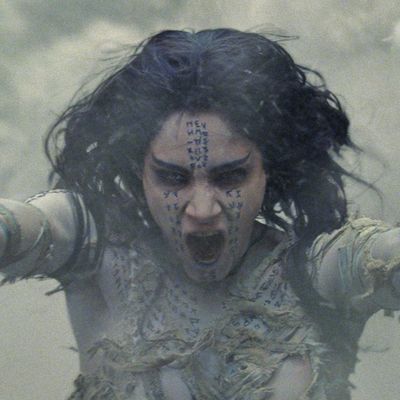
“We constantly transform ourselves emotionally, so why not do it physically?” asks Sofia Boutella, who has been making a recent habit of blockbuster metamorphoses. After a big-screen breakthrough in 2015’s Kingsman: The Secret Service, where she popped as a henchwoman with blades for legs, Boutella slathered herself in striking white makeup for last year’s Star Trek Beyond to play the curious alien Jaylah. She made herself over once again this week for the new big-screen reboot of The Mummy, where the 35-year-old Algerian actress has the title role opposite Tom Cruise. “It’s a part of the job, and I’m embracing it,” Boutella told Vulture. Here’s how she made her mummy come to undead life.
Look for the connection
When The Mummy director Alex Kurztman first sent Boutella the script for his reboot, she wasn’t convinced. “I remember reading it and I thought, Uh, no, I’m not doing this,” laughs Boutella. “The first script I read was a work in progress, a template just to start off preproduction, and I was afraid to just play a monster who walks around town scaring people.”
After Kurtzman sat down with Boutella to talk over the role, it started to expand. No longer just a mostly mute bogeywoman, this version of the mummy has royal lineage and a dark backstory: Born Princess Ahmanet in ancient Egypt, the character is supposed to inherit an entire kingdom until her father sires a son. Robbed of what she feels is her birthright, Ahmanet pacts with the god Set to kill her family and, once unleashed in the present day, rain down even more destruction.
“I had to empathize with her, and I wanted to humanize her,” says Boutella. “The beauty of the original monster movies is that you were able to relate to every single character, or even to treat their monstrosity as an emotional metaphor.” So even though Ahmanet chooses an evil path, Boutella sees those supernatural enhancements more like a protective shell: “It’s about closing yourself off from the people who were supposed to love you,” she says. “If you’ve ever been hurt to that extent, it’s hard to come back from.”
Move like a mummy
A former dancer, Boutella spends a lot of time pondering her character’s movement. “I think people can tell you a lot about themselves before they even start talking, just by how they sit or how they walk,” she says. “Finding the physicality with Ahmanet was very important. I want to show her strength and power through her body.”
So yes, Ahmanet may move with the same sort of stiff purpose you’d associate with other big-screen renditions of the mummy, but Boutella gives that deliberate pace a more regal bearing: “She carries herself as royalty, even more so after she’s been denied.”
Live in the look
There are several phases to Ahmanet’s look, including a mortal period that goes heavy on the bangs and eyeliner, an undead version of Ahmanet where she’s covered in tattoos, and a desiccated, underpowered form where she’s mostly muscle and sinew. That meant even before Boutella got to set, she sat for dozens of makeup and wardrobe tests. “We wanted to find something that’s never been done,” she says. “The longest makeup session was six hours, and even the shortest was four hours.”
And while many big-screen baddies these days involve computer-generated accoutrements, almost all of Boutella’s main mummy look was done for real, from those all-over tattoos to her long, precarious nails. Only Ahmanet’s double-irised eyes were generated in postproduction. “It would have been too intense to handle, but they did try it in some of those screen tests!” she says. “I remember there was one look where my tongue was the only thing on my body that was not touched up … and after that, they came and started putting ink on my tongue to make it look darker.”
Though Boutella knows all that makeup is worth it — “I needed people to look at me the way they did once I had it on” — that doesn’t mean it’s easy to endure its application every day. “The whole makeup team is full of artists who are so compassionate, and that’s so important because it was really, really hard,” she says. “They’re artists, and I had to embrace being a blank canvas every single morning. I had to learn how to meditate through it.” A trick she learned on Star Trek Beyond helped, too: “I came up with a massage table on the last one. I had to! There was no way I was sitting down for six hours.”
Incorporate a sense of play
When you’re working on an effects-heavy blockbuster, wearing a lot of expensive makeup, and carefully hitting all your marks, there’s not a lot of room to experiment. Still, Boutella treasured the times when she could have fun with her role, none more so than when Ahmanet confronts Cruise’s hero in the film’s final third and unsettles him by using her inky tongue to deliver one long lick to his face.
“That was not in the script,” she says. “It came on the day, and it was Alex’s idea. We went from ‘What?’ to ‘Oh, good idea!’ And we had so much fun. I did it about eight times and it was a great, great laugh on set.” By the end of it, Boutella was in no hurry to return to that massage table: “I think we should have done it more, actually.”
Boutella is trying to approach her career with the same sort of openness: Next up, she’s got far more down-to-earth roles in Atomic Blonde and an HBO adaptation of Fahrenheit 451, neither of which necessitates much time in the makeup chair. “I won’t complain, but I don’t want to just be doing action films and extended character transformations, you know?” she says. “I want to explore and I’m up for anything. Honestly, I just want to read a good script and fall in love.”

